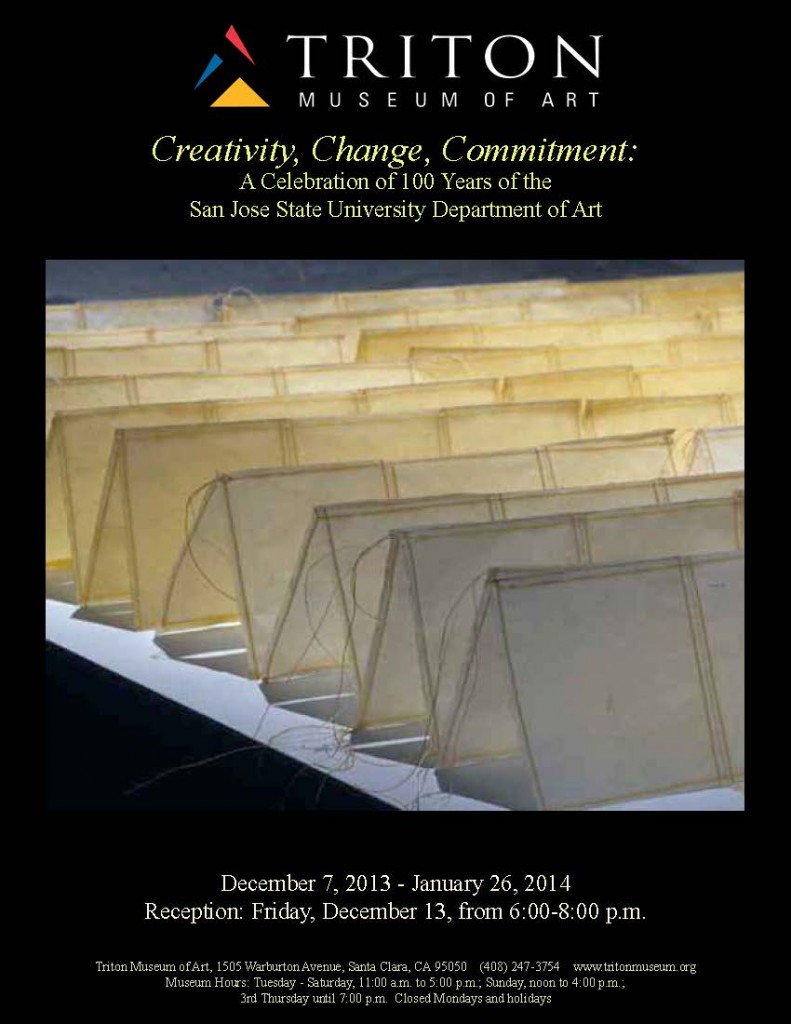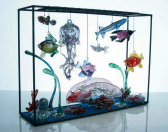
A poster for the campus exhibition featured a photo of the Art Building in the 1960s (SJSU Archives and Digital Collection).
For more information, please contact Jo Farb Hernandez (408-924-4328).
It is as important to mark rites of passage for institutions as for individuals. In each case, stopping to observe a transitional moment has particular importance amid the crush of what has become the new “normal” of our busy daily lives: it motivates us to celebrate growth, honor milestones, or commemorate passings. And, by so doing, it inspires us to take stock, to note the challenges and the successes, the drawbacks and the rewards. It reminds us to take a breath and look back from where we have come, appreciate where we are now, and look forward to what lies ahead.
Foundation in Art
As we have paused to consider one hundred years of the Department of Art at San Jose State University, the view to the past is astonishing. SJSU was inaugurated as a teachers’ or normal school in 1857, and, in 1862, was absorbed by the state of California, becoming not only the first of the state’s teachers’ colleges, but California’s first state-supported institution of higher learning. In 1871, the college was moved from its original San Francisco location after administrators and the legislature decided that rural San Jose would be a safer location for its predominantly young, female and unmarried students. Classes in drawing were among the earliest courses taught and, for a long time, these classes were required for every student, no matter their major or intended career. Classes in additional media and techniques were added quickly, as the administrators at that time understood that the study of the arts were essential in the development of a well-rounded, educated individual. Soon the San Jose Normal School evolved into the San Jose State Teacher’s College, then into San Jose State College, and finally into San Jose State University.

A series of events have been scheduled to celebrate this important milestone including an exhibit at the Triton Museum of Art in Santa Clara, Dec. 7, 2013 – Jan. 26, 2014. This poster features the work of alumna Pilar Aguero-Esparza.
A series of exhibitions, projects, and programs were scheduled to celebrate this important milestone of the art department. Sponsors include Adobe Systems, Cisco and Lathrop Construction, which gave $5,000 each. In the Thompson Art Gallery, we focused on a small number of our most illustrious alumni from the middle years of our history – including Jay DeFeo, Wayne Thiebaud, Mel Ramos, Robert Graham, Mark Tansey and Tim Hawkinson. Complementary exhibitions on campus took place in Gallery 3 (Nov. 12-22, 2013), with a very special exhibition of the work of three generations of the Amyx family: the grandfather, father, and son all received their art degrees at San Jose State; and there was also an exhibition of department-produced posters at King Library. Off-campus, the community is helping celebrate, as well: there were or will be broad displays featuring dozens of our alumni at the new gallery at San Jose City College (curated by Eve Mathias, Nov. 14 – Dec. 12, 2013), at the Triton Museum of Art in Santa Clara (curated by Jo Farb Hernandez, Dec. 7, 2013 – Jan. 26, 2014), and at San Jose City Hall (curated by Robin Treen, February – May 2014).
Commemorative Book
A hardcover book documenting the past hundred years, and including images by or narratives about more than 160 alumni, as well as faculty, staff, and programs, has been produced by the gallery and is available for purchase ($30 for students, faculty, staff and alumni; $50 for the general public). In conjunction with the opening of the exhibition, a special panel discussion was moderated by Professor of Art History Christy Junkerman and included illustrated presentations by the art history alumni who wrote the substantive narrative essays in the book—Kathleen Kenyon, who spoke on the period 1911-1945; Marianne Kennedy McGrath, who discussed 1946-1970; and Betsy Vaca, who focused on the more recent past 1971-2013—providing an overview of the project and the astonishing changes that have taken place over the past 100 years.

